[dropcap letter=”A”]n eerie stillness looms over unused boats and impromptu graveyards of empty crab traps at Pillar Point Harbor in Half Moon Bay, a place typically alive with activity at this time of year. Without the usual income from the Dungeness crab season that supports his family, Don Marshall, along with many other fishermen around the Bay, wonders how he will make ends meet.
“If you had asked me six months ago about crab, I would’ve told you we’re going to feed our families, we’re going to send our kids to college. And I’m not talking just the junior college. If they want to go to Princeton, crab can make this happen with my work ethic,” said Marshall, who recently took out a loan to buy the permit for his new boat, the F/V Janet E. Donald. “This [situation] is a new one. This was like getting the legs pulled out from under you.”
The Dungeness crab fishery was closed until further notice on Nov. 6, one week before the commercial fishery was scheduled to open. The California Department of Fish and Wildlife made the emergency decision after the Office of Environmental Health Hazard Assessment and the California Department of Public Health established Dungeness crab unsafe to eat due to dangerously high levels of a neurotoxin called domoic acid.
The closure that is devastating fishermen is caused by microscopic algae within a harmful algal bloom off the California coast. El Niño and a warm water mass scientists nicknamed “the blob” are partially to blame for the higher than average water temperatures that have brought on the bloom, according to Raphael Kudela, a marine scientist at the University of California, Santa Cruz whose lab models the bloom.
The bloom contains a type of unicellular algae called Pseudo-nitzschia, which produces domoic acid. That acid moves up the food chain to the dinner table when shellfish take it into their systems as they feed, crab then eat the contaminated shellfish and humans eat the newly contaminated crab. People who consume domoic acid can face symptoms ranging from dizziness to death.
The last reported outbreak of domoic acid was in 1987 in Canada, when 107 people who consumed contaminated mussels suffered amnesiac shellfish poisoning, which can cause permanent short-term memory loss. According to the California Department of Public Health, domoic acid was discovered in the state for the first time in 1991, but human poisoning — from crab or any other source — has never been reported. It is likely that some people, especially indigenous tribes in the Pacific Northwest with long-term exposure to crabs and shellfish, have suffered domoic acid poisoning, but symptoms are so similar to food poisoning that many cases probably go unreported, says Kudela.
Harmful algal blooms and the presence of small amounts of domoic acid in Dungeness crab are not abnormal. What is abnormal this year are the scale and longevity of both the bloom, which stretches 1,000 miles along the California coast, and consequent domoic acid levels, which are well above the 30 parts per million established as safe by regulatory agencies.
“We’ve never closed a crab fishery for domoic acid before,” said Jordan Traverso, deputy director of the office of communication at the California Department of Fish and Wildlife. The fishery, which usually runs from the beginning of November to mid-July, has been delayed in previous years for various reasons — from fishermen strikes to poor product quality. Closure for the entire season, however, would be unprecedented.
In a typical year, thousands of crab fishermen and deckhands from Oregon, Washington, Alaska and California congregate in the area from Santa Barbara County to the Oregon border to take advantage of a fishery that last year yielded about $60 million, and in 2012 yielded nearly $100 million in revenue for fishermen. This region in particular attracts so much manpower because nowhere else on the West Coast does the commercial Dungeness crab fishery open before Dec. 1. This window between early November and December is critical for fishermen taking advantage of the holiday season, when crab aficionados buy Thanksgiving and Christmas meals that traditionally feature Dungeness crab.
Most of that money is made in the first month after the fishery opens, in a flurry of hard and fast labor when many fishermen run on 24-hour crabbing schedules, rotating crews who operate on two hours of sleep as they vie for space to pull up as many crab traps as they can, as quickly as they can. Many fishermen estimate that most of the crab is harvested in the first two weeks.
Even if the season does open and Dungeness crab returns to the market, many predict consumers will not be receptive after months of focus on a potentially fatal neurotoxin.
“I’ve stopped buying crab the past three weeks because none of the customers want it anymore,” said wholesale distributor Greg Pfotenhauer at the New England Lobster Company.
The lack of readily available, safe crab in California has driven its market price up to about $50 per crab. Lobster is now routinely cheaper than Dungeness crab, said Dylan MacNiven, owner of Woodhouse Fish Company, in an email. Restaurants like Woodhouse Fish Company, the Crustacean, Crab House At Pier 39 and The Franciscan Crab Restaurant are importing Dungeness crab from more northern states, mainly Washington.
Washington and Oregon have also experienced higher than normal domoic acid levels this year, but their levels are not as high as those in California. Washington and Oregon recreational Dungeness crab fisheries are currently open, but both have delayed their typical Dec. 1 commercial opening date.
That delay will continue, according to an industry notice released Dec. 7 by the Washington Department of Fish and Wildlife after a meeting of the Pacific States Marine Fisheries Tri-State Dungeness Crab Commission (comprised of Washington Oregon, and California) the same day. Fishery managers from California, Oregon and Washington “will meet on Friday, Dec. 18 (or sooner) to make a decision on the opening south of Klipsan,” according to the report.
Crabbers, though eager to fish again, are painfully aware that already low consumer confidence could be crushed entirely if there is even one reported case of domoic acid poisoning. “Crab fishermen can hold on and toe the line for public safety, and for our industry,” said Marshall. “Because if somebody gets sick, if one or two people get sick, our crab is all of a sudden worth half, or nothing, to us. We will be gone in one fell swoop.”
‘We are so sorry’
Most crab fishermen invest in other fisheries so as not to be fully dependent on the crab industry, said Phoebe Higgins, director of the California Fisheries Fund, which provides loans to fishermen like Marshall. However, the summer salmon season this year yielded one third of the average harvest, according to the California Department of Fish and Wildlife.
“I’m not the only one that spent the last of their money to kind of double down after a bad salmon season,” said Marshall. “Crab has always been the consistent product for us. It’s been resilient. During the holidays everybody wants crab. Now we have multiple months of waiting, with no money earning, without warning.”
There are approximately 600 vessels permitted for Dungeness crab this year, each of which is likely to employ two or three deckhands, according to Peter Kalvass, senior environmental scientist at the California Department of Fish and Wildlife. Right now most of those vessels are “rotting in the harbor,” said Nikko von Broembsen, a commercial fisherman who goes by Sharkie, when “we have families to feed.”
“Some of us have other ways of bringing in income; some of us don’t,” said Richard Ogg, a commercial crab fisherman based out of Bodega Bay, who is generating income by working as an electrician. Duane Winter, a recreational-turned commercial fisherman, has fallen back on his previous job running a machine shop. Marshall has started work at a Christmas tree lot but the income is not enough to support his family. Cybelle Priestley, who lives on her boat in Half Moon Bay, is considering applying for unemployment benefits.
At a Dec. 3 legislative hearing in Santa Rosa attended by fishermen, state officials, scientists and other industry stakeholders von Broembsen said: “What are we going to tell [employers] — ‘employ me, but I might be gone in three weeks to go fishing’?”
The briefing, spearheaded by California State Senator Mike McGuire, focused on exchanging current knowledge and brainstorming ways forward.
Lawmakers said public safety has to be paramount but acknowledged they didn’t realize the full extent of the fishermen’s struggle. “We are so sorry,” McGuire told the fishermen assembled at the Steele Lane Community Center. California Department of Fish and Wildlife Director Charlton Bonham also apologized.
“You, all of us sitting there, are all in this together,” Bonham told the fishermen at the briefing.
“We’ll redouble our efforts,” said Patrick Kennelly, chief of the food safety section of the California Department of Public Health, in response to complaints that domoic acid testing is not expedited enough. All of the results of the most recent Nov. 28 test have yet to be made public.
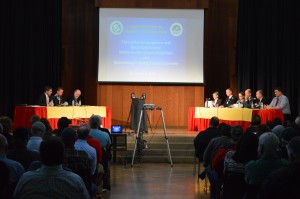
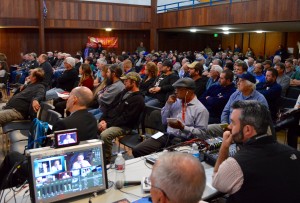
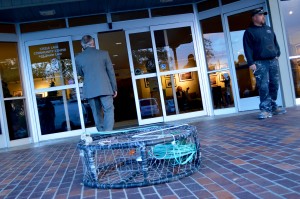
Every two weeks, fishermen in nine locations around the Bay collect samples of at least six Dungeness crab, which are then given to the California Department of Public Health for testing. All crab in the samples must test below 30 parts per million in two consecutive tests spaced at least seven days apart to be considered safe. Test results have thus far been largely inconclusive.
“There is continued frustration because of the fluctuation of [the domoic acid] tests. And that is a significant source of frustration for everyone involved, from pubic health to the industry,” McGuire said in an interview after the hearing.
Dan Kammerer and Tom “TF” Graham, two of the commercial fishermen who currently collect Dungeness crab for testing, say they get calls daily from anxious fishermen wanting updates on the test results. Graham and Kammerer, along with the other fishermen who collect the crab for testing, have not received any compensation for the cost of such excursions.
The way forward
With pressure mounting, Congressional representatives Jared Huffman, Sam Farr, Jackie Speier and Lois Capps sent a letter to Gov. Jerry Brown on Nov. 24 requesting the state consider compensation for the fishermen in the event of a permanent closure. How much this compensation would include and when it would be provided is still unclear.
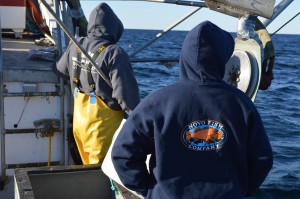
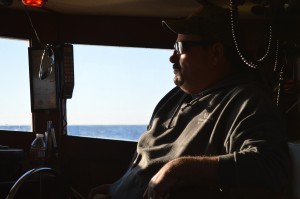
For fishermen like Marshall, the only way forward is to find a way to make ends meet in the short-term, while holding out hope the commercial Dungeness crab fishery will open. Fishing is Marshall’s lifelong dream and passion. He is one of the youngest fishermen in the business and wants to do it for the rest of his life, but he’s no longer sure that will be possible. When asked what he would do if the Dungeness crab fishery did not open at all this year, he said he would likely have to sell his new boat at a loss, “demote” himself to working for someone else’s fishing operation or leave the industry entirely.
“We all gotta just hold on,” he said, “When we have our moments of weakness, we need to stay together. And one of us needs to talk the other one out of the craziness, like selling out and ‘we can’t do this no more’ and ‘it’s over,’ because it grips you sometimes.”
